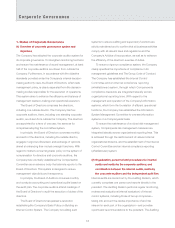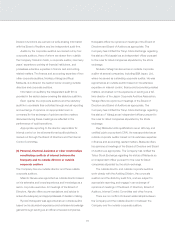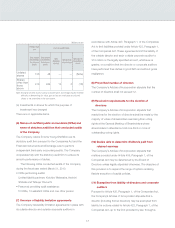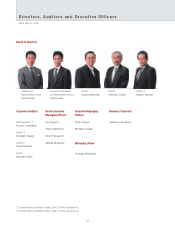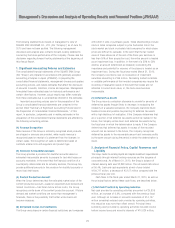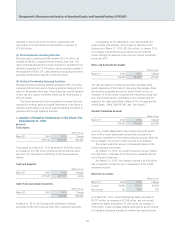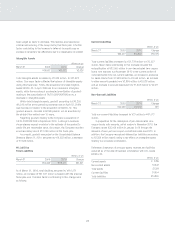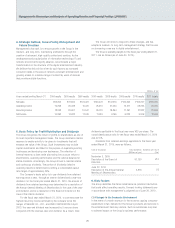Square Enix 2010 Annual Report Download - page 23
Download and view the complete annual report
Please find page 23 of the 2010 Square Enix annual report below. You can navigate through the pages in the report by either clicking on the pages listed below, or by using the keyword search tool below to find specific information within the annual report.
Management’s Discussion and Analysis of Operating Results and Financial Position (JPNGAAP)
The following statements are based on management’s view of
SQUARE ENIX HOLDINGS CO., LTD. (the “Company”) as of June 30,
2010 and have not been audited. The following management
discussion and analysis also contains forward-looking statements
concerning the future performance of the Company. Please read the
disclaimer regarding forward-looking statements at the beginning of
this Annual Report.
1. Significant Accounting Policies and Estimates
The consolidated financial statements of the SQUARE ENIX Group
(the “Group”) are prepared in accordance with generally accepted
accounting principles in Japan (JPNGAAP). In preparing the
consolidated financial statements, management chooses and applies
accounting policies, and makes estimates that affect the disclosure
of amounts in assets, liabilities, income and expenses. Management
formulated these estimates based on historical performance and
certain other factors. However, actual results may differ materially
from these estimates due to uncertainties inherent in the estimates.
Important accounting policies used in the preparation of the
Group’s consolidated financial statements are contained in the
section titled “Summary of Significant Accounting Policies Used in
the Preparation of Consolidated Financial Statements,” of this
report. In particular, judgments used in making estimates in the
preparation of the consolidated financial statements are affected by
the following accounting policies.
(1) Revenue Recognition
Sales revenue of the Group is ordinarily recognized when products
are shipped or services are provided, while royalty revenue is
recognized based on receipt of a statement from the licensee. In
certain cases, the recognition of sales is determined based on
contracts entered into with suppliers and product type.
(2) Provision for Doubtful Accounts
The Group provides a provision for doubtful accounts based on
estimated irrecoverable amounts to prepare for bad debt losses on
accounts receivable. In the event that the financial condition of a
counterparty deteriorates and its solvency declines, the Group may
provide additional amounts to the provision for doubtful accounts or
record bad debt losses.
(3) Content Production Account
When the Group determines that the estimated market value of the
content production account—based on expected future demand and
market conditions—has fallen below actual costs, the Group
recognizes a write-down of the content production account. If future
demand and market conditions are worse than management’s
forecasts, there is the possibility that further write-downs will
become necessary.
(4) Unrealized Losses on Investments
The Group owns shares in certain financial institutions and companies
with which it sells or purchases goods. These shareholdings include
stock in listed companies subject to price fluctuation risk in the
stock market and stock in privately held companies for which share
prices are difficult to calculate. In the event that the fair market
value of these shares as of the end of the fiscal year declines no
less than 50% of their acquisition cost, the entire amount is treated
as an impairment loss. In addition, in the event of a 30% to 50%
decline, an amount determined as necessary considering the
importance and potential for recovery of the shares is treated as an
impairment loss. During the fiscal year ended March 31, 2010,
the Company recorded a loss on revaluation of investment
securities amounting to ¥166 million. Worsening market conditions
or unstable performance at the invested companies may require the
recording of revaluation losses in the event that losses are not
reflected in current book value, or, the book value becomes
irrecoverable.
(5) Deferred Tax Assets
The Group records a valuation allowance to provide for amounts of
deferred tax assets thought likely to decrease. In evaluating the
necessity of a valuation allowance, the Company examines future
taxable income and possible tax planning for deferred tax assets
with a high likelihood of realization. If the Company determines that
all or a portion of net deferred tax assets cannot be realized in the
future, the Company writes down such deferred tax assets during
the fiscal year in which the determination is made. If the Company
determines that deferred tax assets in excess of the recorded
amount can be realized in the future, the Company recognizes
deferred tax assets to the recoverable amount and increases profits
by the same amount during the period in which the determination is
made.
2. Analysis of Financial Policy, Capital Resources and
Liquidity
The Group meets its working capital and capital investment requirements
principally through internal funding resources and the issuance of
corporate bonds. As of March 31, 2010, the Group’s balance of
interest-bearing debt was ¥2,808 million. The net assets ratio stood
at 56.4%. Cash and cash equivalents at end of year totaled
¥109,717 million, a decrease of ¥2,157 million compared with the
previous fiscal year end.
Cash flows in the fiscal year ended March 31, 2010, as well as
the principal factors behind these cash flows, are described below.
(1) Net Cash Provided by Operating Activities
Net cash provided by operating activities amounted to ¥20,838
million, an increase of 9.8%, compared with the previous fiscal
year. Although an increase in accounts receivable of ¥14,157
million somewhat reduced cash provided by operating activities,
this reduction was more than offset overall. Principal items
bolstering cash provided by operating activities included income
before income taxes and minority interests of ¥10,026 million,
21





